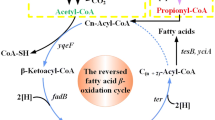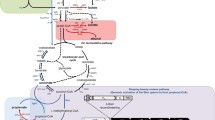Abstract
Nylon 5 and nylon 6,5 are recently explored as new commercial polyamides, of which the monomer includes δ-valerolactam. In this study, a novel catalytic activity of lysine 2-monooxygenase (DavB) was explored to produce δ-valerolactam from l-pipecolic acid (L-PA), functioning as oxidative decarboxylase on a cyclic compound. Recombinant Escherichia coli BS01 strain expressing DavB from Pseudomonas putida could synthesize δ-valerolactam from l-pipecolic acid with a concentration of 90.3 mg/L. Through the co-expression of recombinant apoptosis-inducing protein (rAIP) from Scomber japonicus, glucose dehydrogenase (GDH) from Bacillus subtilis, Δ1-piperideine-2-carboxylae reductase (DpkA) from P. putida and lysine permease (LysP) from E. coli with DavB, δ-valerolactam was produced with the highest concentration of 242 mg/L. α-Dioxygenases (αDox) from Oryza sativa could act as a similar catalyst on l-pipecolic acid. A novel δ-valerolactam synthesis pathway was constructed entirely via microbial conversion from feedstock lysine in this study. Our system has great potential in the development of a bio-nylon production process.
Key points
• DavB performs as an oxidative decarboxylase on L-PA with substrate promiscuity.
• Strain with rAIP, GDH, DpkA, LysP, and DavB coexpression could produce δ-valerolactam.
• This is the first time to obtain valerolactam entirely via biosynthesis from lysine.







Similar content being viewed by others
References
Adkins J, Pugh S, McKenna R, Nielsen DR (2012) Engineering microbial chemical factories to produce renewable “biomonomers”. Front Microbiol 3:313
Adkins J, Jordan J, Nielsen DR (2013) Engineering Escherichia coli for renewable production of the 5-carbon polyamide building-blocks 5-aminovalerate and glutarate. Biotechnol Bioeng 110:1726–1734
Altaras NE, Cameron DC (1999) Metabolic engineering of a 1,2-propanediol pathway in Escherichia coli. Appl Environ Microbiol 65:1180–1185
Atsumi S, Hanai T, Liao JC (2008) Non-fermentative pathways for synthesis of branched-chain higher alcohols as biofuels. Nature 451:86–89
Becker J, Wittmann C (2015) Advanced biotechnology: metabolically engineered cells for the bio-based production of chemicals and fuels, materials, and health-care products. Angew Chem Int Ed 54:3328–3350
Becker J, Reinefeld J, Stellmacher R, Schäfer R, Lange A, Meyer H, Lalk M, Zelder O, Abendroth G, Schröder H (2013) Systems-wide analysis and engineering of metabolic pathway fluxes in bio-succinate producing Basfia succiniciproducens. Biotechnol Bioeng 110:3013–3023
Bermudez M, Leon S, Aleman C, Munoz-Guerra S (2000) Comparison of lamellar crystal structure and morphology of nylon 46 and nylon 5. Polymer 41:8961–8973
Cao YX, Xiao WH, Liu D, Zhang JL, Ding MZ, Yuan YJ (2015) Biosynthesis of odd-chain fatty alcohols in Escherichia coli. Metab Eng 29:113–123
Celinska E (2010) Debottlenecking the 1,3-propanediol pathway by metabolic engineering. Biotechnol Adv 28:519–530
Chae TU, Ko YS, Hwang KS, Lee SY (2017) Metabolic engineering of Escherichia coli for the production of four-, five- and six-carbon lactams. Metab Eng 41:82–91
Cheng J, Huang Y, Mi L, Chen W, Wang D, Wang Q (2018) An economically and environmentally acceptable synthesis of chiral drug intermediate L-pipecolic acid from biomass-derived lysine via artificially engineered microbes. J Ind Microbiol Biotechnol 45:405–415
Chung H, Yang JE, Ha JY, Chae TU, Shin JH (2015) Bio-based production of monomers and polymers by metabolically engineered microorganisms. Curr Opin Biotechnol 36:73–84
Curran KA, Alper HS (2012) Expanding the chemical palate of cells by combining systems biology and metabolic engineering. Metab Eng 14:289–297
Dairo TO, Nelson NC, Slowing II, Angelici RJ, Woo LK (2016) Aerobic oxidation of cyclic amines to lactams catalyzed by ceria-supported nanogold. Catal Lett 146:2278–2291
Eggeling L, Bott M (2015) A giant market and a powerful metabolism: L-lysine provided by Coryne-bacterium glutamicum. Appl Microbiol Biotechnol 99:3387–3394
Hanai T, Atsumi S, Liao JC (2007) Engineered synthetic pathway for isopropanol production in Escherichia coli. Appl Environ Microbiol 73:7814–7818
Huang M, Cheng J, Chen P, Zheng G, Wang D, Hu Y (2019) Efficient production of succinic acid in engineered Escherichia coli strains controlled by anaerobically-induced nirB promoter using sweet potato waste hydrolysate. J Environ Manage 237:147–154
Inui M, Murakami S, Okino S, Kawaguchi H, Vertes AA, Yukawa H (2004) Metabolic analysis of Corynebacterium glutamicum during lactate and succinate productions under oxygen deprivation conditions. J Mol Microbiol Biotechnol 7:182–196
Kaltenbach HM, Wilke A, Bocker S (2007) SAMPI: protein identification with mass spectra alignments. BMC Bioinf 8:102
Koeduka T, Matsui K, Akakabe Y, Kajiwara T (2000) Molecular characterization of fatty acid alpha-hydroperoxide-forming enzyme (alpha-oxygenase) in rice plants. Biochem Soc Trans 28:765–768
Koeduka T, Matsui K, Akakabe Y, Kajiwara T (2002) Catalytic properties of rice alpha-oxygenase. A comparison with mammalian prostaglandin H synthases. J Biol Chem 277:22648–22655
Lee SY, Kim HU (2015) Systems strategies for developing industrial microbial strains. Nat Biotechnol 33:1061–1072
Lee JW, Na D, Park JM, Lee J, Choi S, Lee SY (2012) Systems metabolic engineering of microorganisms for natural and non-natural chemicals. Nat Chem Biol 8:536–546
Liu P, Zhang H, Lv M, Hu M, Li Z, Gao C, Xu P, Ma C (2014) Enzymatic production of 5-aminovalerate from l-lysine using l-lysine monooxygenase and 5-aminovaleramide amidohydrolase. Sci Rep 4:5657
Mats H, Ines PL, Maria JR, Carmen C (2005) a-Dioxygenases. Biochem Biophys Res Commun 338:169–174
Müller M, Katzberg M, Bertau M, Hummel W (2010) Highly efficient and stereoselective biosynthesis of (2S,5S)-hexanediol with a dehydrogenase from Saccharomyces cerevisiae. Org Biomol Chem 8(7):1540–1550
Na D, Kim TY, Lee SY (2010) Construction and optimization of synthetic pathways in metabolic engineering. Curr Opin Microbiol 13:363–370
Naik S, Basu A, Saikia R, Madan B, Paul P (2010) Lipases for use in industrial biocatalysis: specificity of selected structural groups of lipases. J Mol Catal B Enzym 65:18–23
Nguyen CM, Kim JS, Hwang HJ, Park MS, Choi GJ, Choi YH, Jang KS, Kim JC (2012) Production of L-lactic acid from a green microalga, Hydrodictyon reticulum, by Lactobacillus paracasei LA104 isolated from the traditional Korean food, makgeolli. Bioresour Technol 10:552–559
Oh YH, Eom IY, Joo JC, Yu JH, Song BK, Lee SH (2015) Recent advances in development of biomass pretreatment technologies used in biorefinery for the production of bio-based fuels, chemicals and polymers. Korean J Chem Eng 32:1945–1959
Okino S, Noburyu R, Suda M, Jojima T, Inui M, Yukawa H (2008) An efficient succinic acid production process in a metabolically engineered Corynebacterium glutamicum strain. Appl Environ Microbiol 81:459–464
Park SJ, Kim EY, Noh W, Park HM, Oh YH, Lee SH (2013) Metabolic engineering of Escherichia coli for the production of 5-aminovalerate and glutarate as C5 platform chemicals. Metab Eng 16:42–47
Park SJ, Oh YH, Noh W, Kim HY, Shin JH, Lee EG (2014) High-level conversion of l-lysine into 5-aminovalerate that can be used for nylon 6,5 synthesis. Biotechnol J 9:1322–1328
Pukin AV, Boeriu CG, Scott EL, Sanders JPM, Franssen MCR (2010) An efficient enzymatic synthesis of 5-aminovaleric acid. J Mol Catal B Enzym 65(1–4):58–62
Qian ZG, Xia XX, Lee SY (2009) Metabolic engineering of Escherichia coli for the production of putrescine: a four carbon diamine. Biotechnol Bioeng 104:651–662
Revelles O, Espinosa UM, Molin S, Ramos JL (2004) The davDT operon of Pseudomonas putida, involved in lysine catabolism, is induced in response to the pathway intermediate delta-aminovaleric acid. J Bacteriol 186:3439–3446
Revelles O, Espinosa UM, Fuhrer T, Sauer U (2005) Multiple and interconnected pathways for L-lysine catabolism in Pseudomonas putida KT2440. J Bacteriol 187:7500–7510
Rodriguez L, Aguirrezabalaga I, Allende N, Braña AF, Méndez C (2002) Engineering deoxysugar biosynthetic pathways from antibiotic-producing microorganisms: a tool to produce novel glycosylated bioactive compounds. Chem Biol 9:721–729
Schneider J, Wendisch VF (2010) Putrescine production by engineered Corynebacterium glutamicum. Appl Environ Microbiol 8:859–868
Schneider J, Wendisch VF (2011) Biotechnological production of polyamines by Bacteria: recent achievements and future perspectives. Appl Environ Microbiol 91:17–30
Steinbuchel A (2005) Non-biodegradable biopolymers from renewable resources: perspectives and impacts. Curr Opin Biotechnol 16:607–613
Tani Y, Miyake R, Yukami R, Dekishima Y, China H (2015) Functional expression of L-lysine α-oxidase from Scomber japonicus in Escherichia coli for one-pot synthesis of L-pipecolic acid from DL-lysine. Appl Microbiol Biotechnol 99:1–10
Turk SC, Kloosterman WP, Ninaber DK, Kolen KP, Knutova J (2016) Metabolic engineering towards sustainable production of Nylon-6. ACS Synth Biol 5:65–73
Vandecasteele JP, Hermann M (1972) Regulation of a catabolic pathway - lysine degradation in Pseudomonas putida. Eur J Biochem 31:80–85
Wang J, Qin D, Zhang B, Li Q, Li S, Zhou X, Dong L, Wang D (2015) Fine-tuning of ecaA and pepc gene expression increases succinic acid production in Escherichia coli. Appl Microbiol Biotechnol 99(20):8575–8586
Willke T, Vorlop KD (2004) Industrial bioconversion of renewable resources as an alternative to conventional chemistry. Appl Environ Microbiol 66:131–142
Ying HX, He X, Li Y, Chen KQ, Ouyang PK (2014) Optimization of culture conditions for enhanced lysine production using engineered Escherichia coli. Appl Biochem Biotechnol 172:3835–3843
Ying H, Wang Z, Wang J, Feng J, Chen K (2015) Enhanced conversion of L -lysine to L -pipecolic acid using a recombinant Escherichia coli containing lysine cyclodeaminase as whole-cell biocatalyst. J Mol Catal B Enzym 117:75–80
Zhang Y, Xiao Z, Zou Q, Fang J, Wang Q, Yang X, Gao N (2017) Ribosome profiling reveals genome-wide cellular translational regulation upon heat stress in Escherichia coli. Genom Proteom Bioinf 15(5):324–330
Zhu F, Zhong X, Hu M, Lu L, Deng Z (2014) In vitro reconstitution of mevalonate pathway and targeted engineering of farnesene overproduction in Escherichia coli. Biotechnol Bioeng 111:1396–1405
Zhu Q, Chen Q, Song YX, Huang HB, Li J, Ma JY, Li QL, Ju JH (2017) Deciphering the sugar biosynthetic pathway and tailoring steps of nucleoside antibiotic A201A unveils a GDP-l-galactose mutase. Proc Natl Acad Sci U S A 114:4948–4953
Funding
This study was supported by the National Natural Science Foundation of China (grant no. 21978027), the Fundamental Research Funds for the Central Universities (project no. 106112017CDJXFLX0014, 2018CDQYHG0010), the Instrument Developing Project of the Chinese Academy of Sciences (grant no. YJKYYQ20170023), the Science and Technology Service Network Initiative of the Chinese Academy of Sciences (grant no. KFJ-STS-ZDTP-065), and the Drug Innovation Major Project (grant no. 2018ZX09711001-006-003).
Author information
Authors and Affiliations
Contributions
WD and WQ conceived and designed research. XY and WB conducted experiments. ZD and LR contributed new reagents or analytical tools. XY, XX, and SW analyzed data. XY and WD wrote the manuscript. All authors read and approved the manuscript.
Corresponding authors
Ethics declarations
Conflict of interest
The authors declare that they have no conflict of interest.
Ethical approval
This article does not contain any studies with human participants or animals performed by any of the authors.
Additional information
Publisher’s note
Springer Nature remains neutral with regard to jurisdictional claims in published maps and institutional affiliations.
Electronic supplementary material
ESM 1
(PDF 146 kb)
Rights and permissions
About this article
Cite this article
Xu, Y., Zhou, D., Luo, R. et al. Metabolic engineering of Escherichia coli for polyamides monomer δ-valerolactam production from feedstock lysine. Appl Microbiol Biotechnol 104, 9965–9977 (2020). https://doi.org/10.1007/s00253-020-10939-8
Received:
Revised:
Accepted:
Published:
Issue Date:
DOI: https://doi.org/10.1007/s00253-020-10939-8




